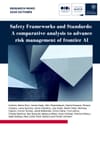⚡ Quick Summary
This Oxford Martin AIGI research memo (Oct 2025) systematically compares Frontier Safety Frameworks (FSFs) from labs (Anthropic, OpenAI, Microsoft, Google DeepMind, Meta) with international risk-management standards (ISO 31000, ISO/IEC 23894, sectoral norms like ISO 14971). FSFs are agile and concrete—using capability thresholds, incident channels, external tests, and deployment gates—but often leave implicit the definition of “risk,” the rationale for thresholds, and the mapping from eval results to severity × likelihood. Standards bring mature structure (scope/context, criteria, analysis → evaluation → treatment, accountability, continual improvement) yet are abstract and not tuned to frontier AI cadence. The memo offers actionable takeaways across six areas (system, criteria, identification, analysis, evaluation, treatment) to fuse FSF innovations with standards discipline for harmonized frontier AI governance.
🧩 What’s Covered
Scope & aim. The memo asks how FSFs compare to international risk standards and what that implies for advancing frontier AI risk management. It surveys FSFs from five major labs and cross-walks them with ISO/IEC families (31000/31073/23894) plus sectoral safety norms (Guide 51; ISO 14971 for medical devices).
Comparative backbone.
- Risk management system. FSFs define governance bodies (e.g., RSO, SSC, AGI Safety Councils), reporting channels, transparency statements, and—sometimes—incident reporting. Standards insist on ultimate accountability at top management, clear separation of management vs. oversight, resourcing, documented comms/consultation, and continuous improvement—not just updates.
- Risk criteria. FSFs operationalize via capability/risk thresholds (often qualitative scenarios per domain like CBRN, cyber). Standards begin with scope & context and require justified criteria: how consequences/likelihood are measured, how risk levels are determined, and how uncertainties are handled. Aviation-style quantitative acceptability examples contrast with FSFs’ qualitative tiers. The memo urges explicit mapping from thresholds to severity × likelihood and internal consistency across tiers.
- Risk identification. FSFs predefine “frontier” risks; some state inclusion criteria (plausible, severe, measurable, net-new, instantaneous/irremediable). Standards emphasize comprehensive processes (sources, events, outcomes, impacts, knowledge limits) and selection of techniques (e.g., threat modeling, HAZOP, FTA). The memo recommends clarifying the risk definition (often “marginal risk” vs. baseline), systematic discovery of emergent risks, and explicit justification of techniques used.
- Risk analysis. FSFs lean on model evaluations with triggers for deeper testing; some add threat modeling, forecasting, context-aware scaffolding, or “target release” analyses. Standards call for multi-method analysis, assessment of existing controls, best-available evidence, and careful transfer learning from “similar devices/models.” The memo highlights the need to translate evaluation outputs into severity and likelihood, and to explain aggregation across techniques.
- Risk evaluation. In standards, evaluation compares analysis to criteria and may lead to many pathways (more analysis, accept, treat, etc.), iteratively pre- and post-mitigation. FSFs pragmatically link to deployment decisions (“release / withhold / stop”) and specify who decides; the memo calls for explicit protocols, documentation, and validation at the right org level.
- Risk treatment. FSFs catalog mitigations (safety, security, staged release, misuse filtering, defense-in-depth) and sometimes bind them to tiers (e.g., ASLs). Standards require justification of options, concrete treatment plans, effectiveness checks, and explicit assessment of residual risk. The memo urges reporting on implementation, sufficiency tests, and how residual risk is weighed against benefits.
Visual notes. The memo’s overview table (pp. 5–7) distills “Key takeaways” per stage (system, criteria, identification, analysis, evaluation, treatment), serving as a quick checklist to operationalize recommendations across the lifecycle.
💡 Why it matters?
Frontier labs and regulators need a common grammar to evaluate when a model’s capabilities cross into unacceptable risk. This memo provides that bridge: retain FSFs’ agility (thresholds, triggers, incident channels, external testing) while importing standards’ rigor (justified criteria, iterativity, accountability, residual-risk logic). The result is a pathway to consistent deployment gates, audit-ready documentation, and internationally harmonized expectations—crucial for compliance with evolving regimes (EU AI Act, codes of practice) and for credible third-party assurance. In practice, the recommendations read like an implementation backlog for any lab or policymaker building a frontier AI risk program.
❓ What’s Missing
- Quantification templates. Concrete examples of converting eval scores into severity/likelihood scales and composite risk estimates.
- Worked governance playbooks. End-to-end, redacted case studies showing who decides what, when, with which evidence, and how documentation flows.
- Technique transfer maps. Clear guidance on adapting safety-critical methods (HAZOP/FTA) to emergent, dual-use frontier risks.
- External testing protocols. Standardized structured-access patterns (scopes, safeguards, liability) to scale third-party evaluations across labs.
👥 Best For
- Policy & standards teams aligning FSFs with ISO/IEC vocabulary and processes.
- Frontier lab safety leads building thresholded gates, external-testing triggers, and residual-risk sign-offs.
- Auditors/assessors needing criteria-to-evidence mappings and documentation touchpoints.
- Regulators drafting codes/practice profiles that marry agility with auditability.
📄 Source Details
Research Memo, Oct 2025. Authors: Marta Ziosi et al. (Oxford Martin AI Governance Initiative, with contributors from SaferAI, AI Standards Hub, MIT FutureTech, and others). 21 pages, comparative analysis with actionable key takeaways per risk-management stage.
📝 Thanks to
Marta Ziosi, James Gealy, Miro Plueckebaum, Daniel Kossack, Simeon Campos, Lama Saouma, Uzma Chaudhry, Lisa Soder, Merlin Stein, Nicholas Caputo, Connor Dunlop, Jakob Mökander, Enrico Panai, Tom Lebrun, Charles Martinet, Ben Bucknall, Rebecca Weiss, Koen Holtman, Patricia Paskov, Saad Siddiqui, Ranj Zuhdi, Peter Slattery, and Florian Ostmann.


